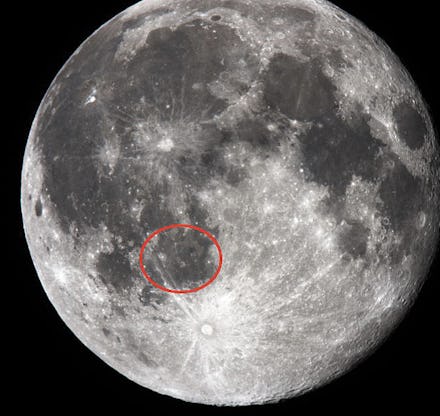The Largest Lunar Impact Ever Just Happened — and Scientists Caught it on Video

Deep impact: Last year on September 11, an asteroid hit the moon. This of course, was unsurprising. Space debris hits the moon — which doesn't have an atmosphere to protect it — all the time. We can see the evidence each time we look up at the moon's cratered surface.
But this one was different. It was BIG. In fact it was the largest lunar impact ever observed. Scientists managed to capture it on video from Earth using the Moon Impacts Detection and Analysis System (MIDAS), a set of telescopes in Seville, Spain. This is how it looked:
Image: J.M. Madiedo
Yes, that's right. The biggest lunar impact ever recorded is a mere flash of light that lasted fractions of a second. But keep in mind that we were viewing it from Earth, 240,000 miles away. The "flash" was the brightest we've ever observed, as bright in the night sky as Polaris, the North Star, and could be seen with the naked eye. All things considered, that flash of light is pretty impressive.
It also means that the impact produced a high energy explosion, equivalent to detonating 15 tons of TNT. The object that created the explosion is estimated to be 2 to 4.5 feet across — equivalent to a decent size boulder — and was travelling at an extremely rapid 38,000 mph, giving the explosion all its energy.
The asteroid hit on a southern region on the dark side of the moon, near Mare Nubium, one of the moon's large dark patches originally formed from ancient volcanoes.
Image: Impact site (Credit: Oxford Journals)
Afterglow: Though the flash remained bright as a Pole Star for only a fraction of a section, an interesting part of the impact was that an afterglow remained visible for 8 seconds. This made the collision not only the most intense, but also the longest ever observed.
Image: A time series of images of the impact. You can see the large flash of the initial collision in the first few frames, followed by smaller but persistent dots, representing the afterglow in most of the remaining frames (Credit: Oxford Journals)
Usually collision flashes last no longer than a second because asteroid rock vaporizes at the impact site instantly, producing the thermal glow that we observe. In this case, scientists believe that the molten material splashed up off the lunar surface and fell back down, resulting in a longer lasting glow of energy.
Images: Examples of "normal" lunar impacts, via J.M. Madiedo
Given the energy observed, there should be a large impact crater. There have been no images of it released yet, but the Lunar Reconnaissance Orbiter (LRO) should be able to grab one from one of its flyovers soon. Last year, the LRO captured this image of a crater resulting from a collision on March 17 that was three times as small:
Image: NASA
An eye on asteroid invaders: Monitoring lunar impacts like these give scientists a chance to study the risk of similar, but larger, objects potentially colliding with the Earth. Professor Jose Madiedo, who made the observation from MIDAS stated, "Our telescopes will continue observing the moon as our meteor cameras monitor the Earth's atmosphere. In this way we expect to identify clusters of rocks that could give rise to common impact events on both planetary bodies. We also want to find out where the impacting bodies come from."
From their time observing lunar impacts in the MIDAS program, scientists believe that collisions of similar sized objects with the Earth occur ten times more often than previously predicted. It's a good thing that the Earth has a decent-sized atmosphere then. Few rocks of this size would survive being burned up in it.
By comparison, asteroids that have the potential to cause chaos like the one that exploded over Chelyabinsk in Russia in February 2013 are much larger (around 62 feet wide in this case), and hit the atmosphere with an energy equivalent to 500,000 tons of TNT. These of course come by much less frequently, but still I'm quite glad that we have MIDAS, and a vast network of telescopes watching over us.